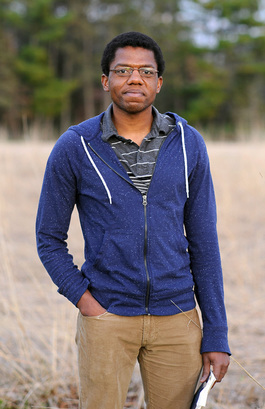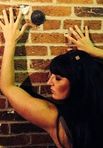Carpe Noctem Chapbook Interview With Bernard Grant
 Let’s start with the book’s title and your cover image. How did you choose each? And, if I asked you to describe or sum up your book, what three words immediately come to mind?
Let’s start with the book’s title and your cover image. How did you choose each? And, if I asked you to describe or sum up your book, what three words immediately come to mind?The book is titled for the last essay. “Puzzle Pieces” is composed of small scenes which are, for the most part, arranged in reverse chronicological order, and is tied together by the recurring image of a woman who pieces a puzzle in front of a window.
Titles are difficult for me, but as I wrote this piece—as I refined the scenes, printed them out, cut them up, and arranged them on the floor until the essay felt right—“Puzzle Pieces” became an obvious choice.
After I completed the manuscript, I felt I’d created a larger version of that essay. Where in that piece short scenes create a bigger picture, the chapbook is composed of short essays that, like puzzle pieces, fit together to create an image, as an experience, in the reader’s mind.
Choosing the right cover image wasn’t as easy as choosing a title. It wasn’t easy at all. But it was just as fun. I contacted a friend, a writer and visual artist, whose work I admire. Clare Johnson read the manuscript a couple of times and met me in a Seattle café with her laptop. We spent two hours looking through images and discussing the essays. She’s a terrific artist and many of her illustrations made great possibilities. There were so many prospects. But I lost interest in all of them once I saw the image I finally chose. I looked at a few more after I saw it, but I’d already made the decision. I liked, among many other things, the way the houses fit together to create a community.
Three words to sum up the chapbook: small, spare, subversive.
What were you trying to achieve with your chapbook? Tell us about the world you were trying to create, and who lives in it.
Creating this chapbook was an act of curiosity: I wanted to see if I could create a longer narrative out of some short essays I’d written. I wondered what story they would tell once I placed them together, given the proper structure.
Can you describe your writing practice or process for this collection? Do you have a favorite revision strategy?
Puzzle Pieces, unlike the full-length fiction manuscript I’m working on now, was assembled from previously-written essays. So my “writing” process for this collection was mostly an act of arrangement. Once I had everything in place, I began to revise, tightening the language and, in some cases, rewriting scenes and changing titles.
I don’t have a specific revision strategy for anything. Maybe I haven’t been writing long enough, or, perhaps, it’s that everything I write—from flash to longer short prose pieces, stories and essays—feels so different, I don’t approach anything the same way. When writing a flash piece, I tend to write it in one sitting, tinker with it a bit, then put it away for a while, try to forget about it, while I draft or revise something else.
Many of these essays took several months to write. I needed time between drafts to figure out what the hell I was writing but I also struggled to find the proper structure and point-of-view for each piece (most are in first person but a couple are in second). One piece was written very quickly, from a Moleskin notebook to MS Word with very few edits. Another piece of similar length took a nearly a year to write, with countless revisions.
How did you order the pieces in the collection? Do you have a specific method for arranging your them or is it sort of haphazard, like you lay the pages out on the floor and see what order you pick them back up in?
Chronologically. Ordering them chronologically allowed the themes to emerge in a way I could understand. The chapbook shrank as a result. I cut a couple of pieces when I began to see the essays as a progression from a narrator who destroys his body to someone who is surrounded by broken bodies to someone who lives with a broken body. I was pleasantly surprised by the other connections that began to emerge once I settled on this structure.
Can you share an excerpt from your book? And tell us why you chose this particular piece for us to read – did it galvanize the writing of the rest of the collection? Is it your book’s heart? Is it the first or last piece you wrote for the book?
As much as it shows my once-obsession with the em dash:
“The man who walks like I did just two months ago—normal gait, normal speed—hurries into the elevator, a smile on his face. He says hello, points to number two, hesitates—as I do, too—presses it, and stands quietly, grinning, until a ding announces our destination.”
This passage comes from the essay “Puzzle Pieces”, which takes place in a physical therapy ward. I like how this paragraph sounds, but I also like what it said to me: we’re in this together. Whatever this is. When I put it into the chapbook, however, the essay, particularly the last line, seemed less about the struggles I shared with other physical therapy patients and more about the struggles I share with every human in existence. Life, like a physical ailment, is harder for some than others, but we all end up in the same place and we all struggle in the meantime. Why not smile? Why not say hello?
For you, what is it to be a writer? What scares you most about being a writer? Gives you the most pleasure?
To be a writer—for me—is to be an artist who is thrilled by the interplay of words, people, life, and sound.
What scares me most about writing is the uncertainty, those questions I ask myself as I write. Will anyone publish this? Do I want someone to publish this? Do I want someone to read this? Who would read this? Who would like it? Would I read this? Will I finish it? Will I like it?
What’s most gratifying about writing is that it helps me to better understand the books I like to read. It’s also energizing to live in the middle of a narrative, when a story or essay is taking shape—when I’m recognizing and exploring thematic connections, rearranging paragraphs, perfecting sentences, etcetera—even when I’m away from my writing desk.
Are there other types of writing (dictionaries, romance novels, comics, science textbooks, etc.) that help you to write?
The Synonym Finder by J.I. Rondale
What are you working on now?
I’m writing a collection of interlinked stories that examines the interactions between emerging and middle-aged adults and captures the interconnectedness of a small city, Olympia, Washington, which is where I lived when I started writing them. The stories are centered around a mixed-race family but the collection moves beyond them and into the community. The more I write, the more I revise, the more the stories begin to resemble chapters, with the book taking the shape of a novel.
I’ve also completed a chapbook-length collection of interlinked flash fiction stories.
What book are you reading that we should also be reading?
Leah Stewart’s latest novel The New Neighbor indulges my fascination with the weaving of multiple perspectives and multiple stories in a single narrative. It isn’t a linked collection (Olive Kitteridge; In Our Time, Winesburg, Ohio) which is my preferred genre, but with its short chapters, and multiple points of view and storylines—there’s also a story within a story—it certainly has that story cycle feel. It’ll hook you.
***
Purchase Puzzle Pieces.
 Bernard Grant has been awarded a 2015 Jack Straw Fellowship and a June Dodge Fellowship. His nonfiction has been nominated for The Best of the Net Anthology and his fiction has appeared or is forthcoming in Chicago Tribune and Crab Orchard Review. He is the author of the nonfiction chapbook Puzzle Pieces (Paper Nautilus Press, 2016) and he serves as the associate essays editor at The Nervous Breakdown. Find him online at www.bernardgrant.com.
Bernard Grant has been awarded a 2015 Jack Straw Fellowship and a June Dodge Fellowship. His nonfiction has been nominated for The Best of the Net Anthology and his fiction has appeared or is forthcoming in Chicago Tribune and Crab Orchard Review. He is the author of the nonfiction chapbook Puzzle Pieces (Paper Nautilus Press, 2016) and he serves as the associate essays editor at The Nervous Breakdown. Find him online at www.bernardgrant.com.
Published on May 17, 2016 04:41
No comments have been added yet.



